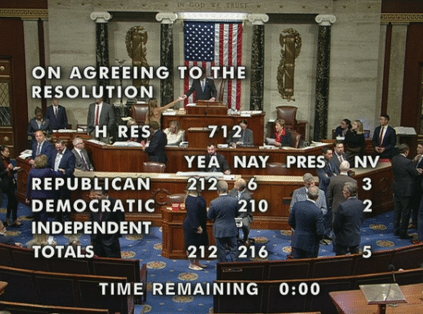If Congress cannot agree to pass a federal budget within the next eight days, the government will shut down at midnight September 30.
Prospects of avoiding a shutdown were dubious Friday amid House GOP infighting that has at times this past week descended into f-bomb laden threats. Congress left Washington after right-wing hardliners iced a plan Thursday to work through the weekend to work to pass a short-term stopgap spending bill. In response, a visibly frustrated House Speaker Kevin McCarthy (R-CA) slammed the far-right members of his caucus, saying they just want to “burn the place down.”
However, there is still at least a glimmer of hope on Capitol Hill. So far, two GOP moderates from New York—Reps. Mike Lawler and Mark Molinaro—said Thursday they’d be willing to team with House Democrats to force a vote on a continuing resolution (CR) to fund the government.
If all House Democrats vote yes on a CR, it would take just five Republicans to join them to pass it. Meanwhile, former President Trump has been encouraging far-right Republicans like Rep. Matt Gaetz (R-FL) to “hold the line” against voting for the CR.
A government shutdown would mean that millions of federal employees and active-duty military service members would stop receiving paychecks, though they’d be forced to report to work anyway.
According to the nonpartisan, non-profit Committee for a Responsible Federal Budget, the following services would be affected:
• Social Security and Medicare
• Environmental and food inspections
• National parks
• Air travel
• Health and Human Services
• The IRS
• Supplemental Nutrition Assistance Program (SNAP)
Mail delivery would continue and seniors would still receive Social Security checks because both are not funded through annual appropriations. But even as the checks are sent out, benefit verification as well as card issuance would cease. For instance, more than 10,000 Medicare applicants were turned away during every day of the 1995-1996 shutdown.
Federal research toward cancer cures and other innovative therapies would pause during a shutdown. Passport offices in parts of the country would also close.
And with each passing day during a shutdown, Washington would continue to deplete federal safety-net programs that count on carrying over unused money from previous years.
The Office of Management and Budget (OMB) maintains a list of various contingency plans for federal agencies to follow during a shutdown. However, it has not been updated since 2018.
The last government shutdown occurred in December 2018-January 2019 and lasted for five weeks in a dispute between then-President Trump and Democratic Congressional leadership over funding his U.S.-Mexico border wall.
According to the non-partisan Congressional Budget Office, that shutdown—the nation’s longest ever—lowered the nation’s projected level of real GDP in the first quarter of 2019 by $8 billion, of which the CBO estimated only $5 billion was recovered.


